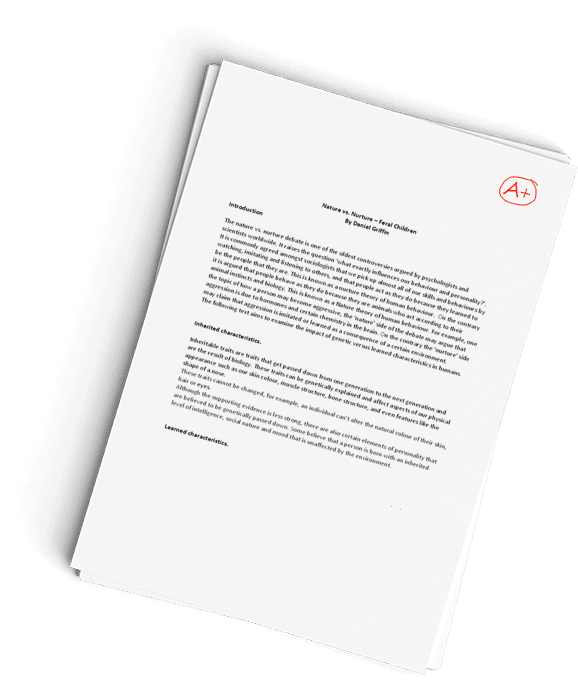LOG 310 GU Lot by Lot Acceptance Sampling Procedures & Logistics Management Essay
Question Description
Research and discuss lot-by-lot acceptance sampling procedures and its role in logistics management
The requirements below must be met for your paper to be accepted and graded:
- Write between 750 1,250 words (approximately 3 5 pages) using Microsoft Word in APA style, see example below.
- Use font size 12 and 1 margins.
- Include cover page and reference page.
- At least 80% of your paper must be original content/writing.
- No more than 20% of your content/information may come from references.
- Use at least three references from outside the course material, one reference must be from EBSCOhost. Text book, lectures, and other materials in the course may be used, but are not counted toward the three reference requirement.
- Cite all reference material (data, dates, graphs, quotes, paraphrased words, values, etc.) in the paper and list on a reference page in APA style.
References must come from sources such as, scholarly journals found in EBSCOhost, CNN, online newspapers such as, The Wall Street Journal, government websites, etc. Sources such as, Wikis, Yahoo Answers, eHow, blogs, etc. are not acceptable for academic writing.
LECTURE:
Acceptance-sampling is concerned with inspection and decision making regarding products, one of the oldest aspects of quality assurance. In the 1930s and 1940s, acceptance-sampling was one of the major components of the field of statistical quality control and was used primarily for incoming or receiving inspection. In more recent years, it has become typical to work with suppliers to improve their process performance through the use of SPC and designed experiments and not to rely as much on acceptance-sampling as a primary quality assurance tool.
A typical application of acceptance-sampling is as follows:
- A company receives a shipment of product from a supplier.
- A sample is taken from the lot, and some quality characteristic of the units in the sample is inspected.
- On the basis of the information in this sample, a decision is made regarding lot disposition; usually to accept or reject a lot. Sometimes we refer to this decision as lot sentencing.
- Accepted lots are put into production; rejected lots may be returned to the supplier or may be subjected to some other lot disposition action.
Three aspects of sampling are important:
It is the purpose of acceptance-sampling to sentence lots, not to estimate the lot quality.
Acceptance-sampling plans do not provide any direct form of quality control. It simply accepts and rejects lots. Even if all lots are of the same quality, sampling will accept some lots and reject others, the accepted lots being no better than the rejected ones. Process controls are used to control and systematically improve quality, but acceptance sampling does not.
The most effective use of acceptance-sampling is not to inspect quality into the product, but rather as an audit tool to ensure that the output of a process conforms to requirements.
Generally, there are three approaches to lot sentencing: Accept with no inspection; 100% inspection and Acceptance-sampling.
The advantages of sampling are: it is usually less expensive, because there is less inspection; there is less handling of the product, and thus reduced damage; it is applicable to destructive testing; fewer personnel are involved in inspection activities; it often greatly reduces the amount of inspection error and the rejection of entire lots as opposed to the simple return of defectives often provides a stronger motivation to the supplier for quality improvements.
The disadvantages to sampling are: there are risks of accepting bad lots and rejecting good lots; less information is usually generated about the product or the process that manufactured the product and acceptance-sampling requires planning and documentation of the acceptance-sampling procedure, whereas 100% inspection does not.
Acceptance-sampling is most likely to be useful in the following situations:
- When testing is destructive.
- When the cost of 100% inspection is extremely high.
- When 100% inspection is not technologically feasible or would require so much calendar time that production scheduling would be seriously impacted.
- When there are many items to be inspected and the inspection error rate is sufficiently high that 100% inspection might cause a higher percentage of defective units to be passed than would occur with the use of a sampling plan.
- When the supplier has an excellent quality history and some reduction in inspection from 100% is desired but the suppliers process capability is sufficiently low as to make no inspection an unsatisfactory alternative.
- When there are potentially serious product liability risks and although the suppliers process is satisfactory, a program for continuously monitoring the product is necessary.
Have a similar assignment? "Place an order for your assignment and have exceptional work written by our team of experts, guaranteeing you A results."








